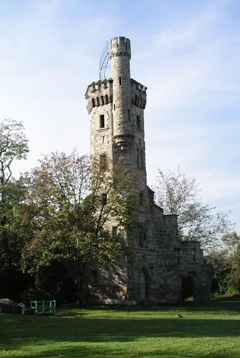Discover a selection of curiosities scattered around the district of Champel. They often bear witness to the history of the district and of Geneva itself.
The Tour de Champel: a tea room for famous spa-goers
Overhanging the cliffs of Champel, this neo-Gothic tower served as a tea room for guests to the therapeutic baths of the Arve, founded nearby in 1874 and demolished in 1991. Focusing on the therapeutic virtues of the River Arve, this spa resort was connected to the railway station by a tramway. Its clientele included the author Guy de Maupassant, the pianist and composer Camille Saint-Saëns, the French philosopher and historian Hippolyte Taine and the winner of the Nobel Prize for literature Romain Rolland. Catering to more modest guests and situated at 25 rue de la Roseraie, the “Pension de la Roseraie”, welcomed the writer Joseph Conrad on several occasions.
The Bout-du-monde sports centre: from war to festivities
A Mecca of multi-sports where all kinds of sporting disciplines are on offer from athletics to football, tennis, fencing and many more, the Bout du Monde sports centre was built after World War One under the name “Stade de Champel”. While it is now hosts numerous sports events, concerts and festivals, its history is somewhat murkier: during World War Two, it became a transit hub for thousands of refugees, including numerous Jewish children from France. It was in Val-Fleuri, the largest camp established by the Swiss authorities, that refugees entering via the border at Geneva were subject to medical and political quarantine. They were then moved on to other places of temporary residence, sent to civilian labour camps or turned away.
The elephant in the Parc Bertrand: a work of art for children
Emblematic of the district, the Parc Bertrand is a vast area ideal for families to enjoy a stroll or their favourite leisure activity. In particular, it boasts attractive areas scattered with trees and a white garden consisting solely of white flowers. Children can enjoy a splash in the paddling pool and make the most of the numerous structures, including "Le grand Jumbo" (Jumbo III, 1978) slide, a giant sculpture in galvanised iron built by the artist Pierre Siebold.
A stele to repent before the torment
It was in Champel that the executioner performed his grisly task at the top of the modern-day rue Beau-Séjour. The most famous person to be condemned was Michel Servet, burned alive on 27 October 1553 for having rejected the concept of the Christian Trinity. His prolonged agony haunted the conscience of Geneva’s protestant for many a long year before they erected a stele of repentance in 1903 where he suffered his torments. The Champel gallows fell into disuse in the 18th century, but its outline continued to frighten the local inhabitants. It is even said that this delayed the urbanisation of the sector.
Some works, monuments and tourist sites in Champel
Sources:
- Véronique Palfi, Tour de Champel. Etude historique, Genève: Conservation du patrimoine de la Ville de Genève, 2007
- Christian Vellas, Genève insolite et secrète, Tours: Jonglez, 2010
- Ville de Genève, sous la dir. de Rafael Matos-Wasem, Genève à pied. 10 parcours à thèmes, Genève: Editions Slatkine, 2008
Article modifié le 25.09.2020 à 17:05

